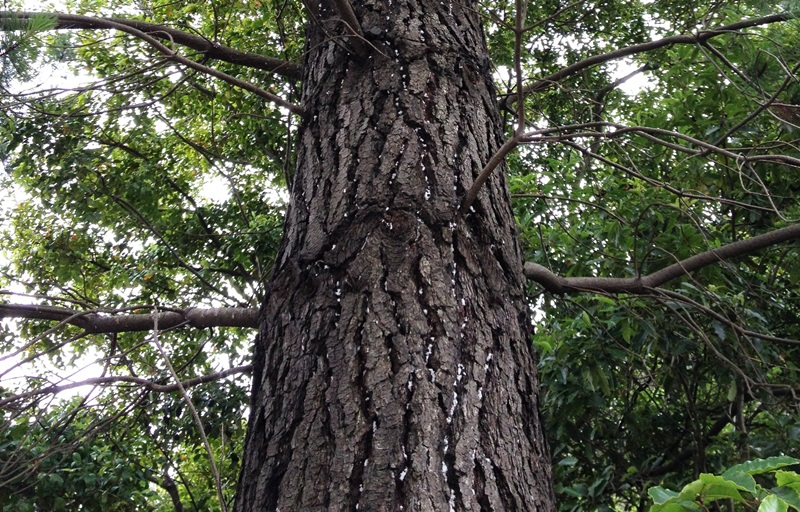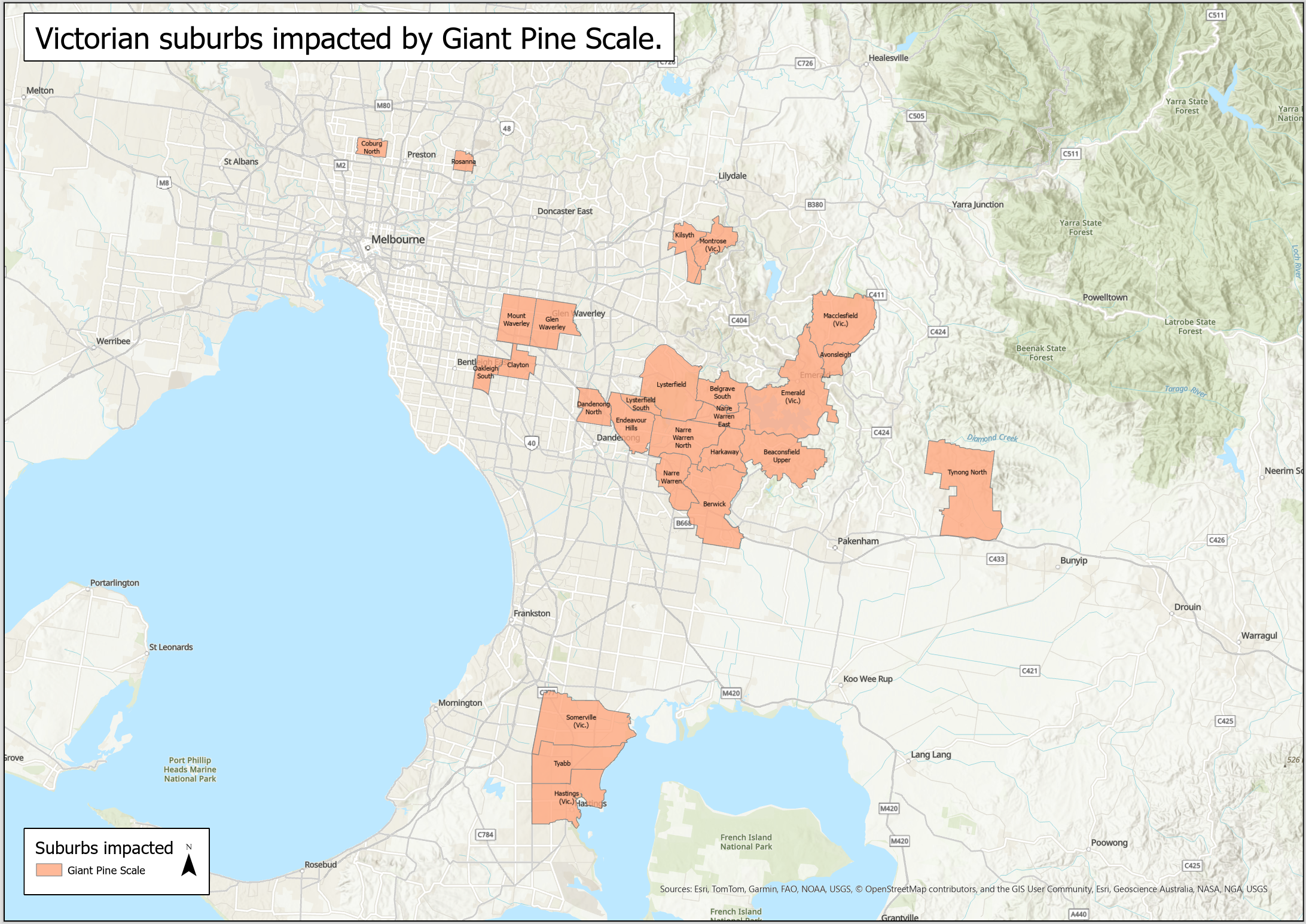Giant pine scale
Giant pine scale (GPS) (Marchalina hellenica) is a large insect that lives by sucking the sap of pine, fir and spruce trees.
If left unmanaged, this insect can build up to large numbers. Heavily infested trees can dry up and die, impacting our parks, forests, softwood plantations and residential properties.
An active containment program is under way in Victoria. Early reporting is essential to stop the spread. You can report suspected sightings of giant pine scale to Agriculture Victoria by using the public online reporting form or phoning our customer contact centre on 136 186.
Take the Giant pine scale eLearning course. Note this course is hosted on the Agriculture Victoria learning management system. Please register and choose this course from the Goals catalogue.
Description
GPS is a large, sap-sucking scale insect that reaches a length of 8 to 19 mm long and 3 to 5 mm wide (Figure 1).
It produces a distinctive, white cotton wool-like waxy secretion that is a by-product from sap feeding. The waxy substance protects the insect and eggs from drying out (Figure 2) and is visible in the cracks of the rough bark on the trunks (Figure 3) and branches (Figure 4) of pine trees.
The pest typically prefers the lower part of the tree but will move on to branches as numbers increase.




Potential impact of feeding damage
Giant pine scale live in large numbers and can affect the health and safety of the trees they live on.
Heavily infested trees can dry up from the insects feeding on the tree's sap, which cause wilting, early needle drop and branch dieback. This results in tree decline, which is made worse by high-density settlement of the host tree by bark beetles that can detect plant stress and preferentially attack weakened trees.
The honeydew secretions can also make the tree susceptible to infections by sooty mould.
The potential effect of GPS on commercial softwood plantations would be economically damaging to the industry.
Host trees
In Australia, GPS has been detected on 3 host species of pine:
- Pinus halepensis (Aleppo pine)
- Pinus radiata (Monterey pine)
- Pinus pinea (stone pine)
Overseas, giant pine scale has also been found on:
- pines (Pinus brutia, P. sylvestris, P. kochiana, P. laricio tauricus, P. nigra salzmannii, P. sosnowskyi)
- firs (Abies cephalonica, A. nordmenniana)
- spruces (Picea engelmanni, P. orientalis).
Non-host trees
Trees that can look similar to pines, spruces and firs but are not hosts of giant pine scale include cypresses (Araucaria, the monkey puzzle tree), she-oaks (Allocasuarina, Casuarina) and cypress-pines (Callitris).
Lifecycle
GPS has one generation per year.
Between November and January each year, adult females produce 300 to 400 eggs that are retained within the female body and hatch after the death of the female.
There are 2 juvenile stages (called crawlers). The first stage crawlers are initially only 1 mm in length and are present between late November and May. The second stage grows up to 7 mm in length and appears between May and September.
Adult females do not have wings. The winged males are rarely seen.
Distribution
This insect is native to eastern Mediterranean regions – specifically, Greece and Turkey.
Giant pine scale in Victoria
Giant pine scale was confirmed in Melbourne's south-eastern suburbs and in Adelaide for the first time in 2014.
Infested trees are present in suburban Melbourne and current known areas of GPS infestation can be found on the map below (Figure 5).
Spread
Giant pine scale spreads by moving up and down and between host trees, up to 50 m in one year.
People can also unintentionally spread it when they:
- move infested plant material (for example, branches, mulch and logs)
- use contaminated gardening equipment
- carry it on clothing, machinery and cars.
So it’s important to take precautions to avoid spreading the pest to other trees.
Managing giant pine scale
The following gardening and equipment hygiene tips will assist residents, landholders, gardeners and contractors in managing giant pine scale-infested trees to avoid further spread.
Residents and landholders
If you have giant pine scale on your property, there are a range of things you can do to help minimise its spread:
- Where possible, keep fallen or cut tree branches on your property.
- Cut any infested branches that hang over the house or any structures (for example, sheds, tanks, swings and fences).
- Dispose of unwanted tree branches, needles and pine cones using a biosecurity-approved method to avoid further spread.
- Clean all plant material off gardening equipment using an 80% methylated spirits to 20% water solution and a brush or paper towel.
- If you decide to have the tree removed, hire an arborist who has been trained in handling giant pine scale-infested trees.
Contractors working with infested trees
When working on infested trees, it's important to practise good plant and equipment hygiene to avoid spreading giant pine scale to other properties:
- When entering a site, take a hygiene kit with you that includes paper towels, 80% methylated spirits to 20% water solution, a bristle brush, disinfectant wipes, plastic bags and spare clothes.
- Check the site for any pests or diseases.
- Clean and decontaminate equipment between trees using the methylated spirit solution or disinfectant wipes.
- Clean and decontaminate your machinery, tools and clothing (or change into spare clothing) before leaving the site.
- When transporting infested material for disposal, remember to fully cover your load so insects don't escape during transit and to dispose of material to avoid further spread.
Photo credits
Figures 1–5, Agriculture Victoria, Department of Energy, Environment and Climate Action (DEECA).
Reporting an unusual plant insect pest or disease
Report any unusual plant pest or disease immediately using our online reporting form or by calling the Exotic Plant Pest Hotline on 1800 084 881. Early reporting increases the chance of effective control and eradication.
Please take multiple good quality photos of the pests or damage to include in your report where possible, as this is essential for rapid pest and disease diagnosis and response.
Your report will be responded to by an experienced staff member, who may seek more information about the detection and explain next steps.
Report online